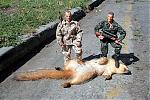
Originally Posted by
BushrangerCZ

Only difference between SF and infantry in the matter of assault rifles I see in caliber and barrel lenght (SF should have the infantry standard issue rifle, plus the same with shorter barrel and/or different caliber, due to the fact that they have some similar, but some different tasks than infantry, like hostage rescue, VIP protection etc., where .308 caliber, which I suppose to be the best for infantry, would not be the best for the task). Also SF rifle needs details like ability to carry a supressor. But SCAR rifles have all these options, thatīs the reason I see SCAR rifle as the best choice for whole army, even if it was developed for SOF purpose. I see every day in job that everybody and his dog wants to call himself SF (cooks, staff officers, logistic guys are experts on this), but thatīs another story. Reliability, simplicity, accuracy, easy maintenance are the same principles for everybody.
PS: I agree that M4 is not the best rifle, but itīs not bad either. Itīs light and accurate, and if you choose right manufacturer, it is also reasonably reliable. SA80 is heavy, and usable only for right shoulder - or at least it used to be, I am not sure about the newest version. On the other hand, I like the safety selector, and cocking handle is definately better designed than in AR15 family.








 ).
).





Bookmarks